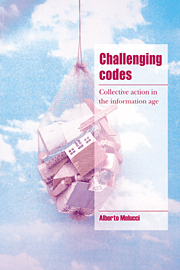Book contents
- Frontmatter
- Contents
- Preface and acknowledgements
- Introduction
- Part I Theory of collective action
- Part II Contemporary collective action
- Part III The field of collective action
- 11 A society without a centre
- 12 The political system
- 13 The state and the distribution of social resources
- 14 Modernization, crisis, and conflict: the case of Italy
- Part IV Acting collectively
- References
- Index
12 - The political system
Published online by Cambridge University Press: 23 November 2009
- Frontmatter
- Contents
- Preface and acknowledgements
- Introduction
- Part I Theory of collective action
- Part II Contemporary collective action
- Part III The field of collective action
- 11 A society without a centre
- 12 The political system
- 13 The state and the distribution of social resources
- 14 Modernization, crisis, and conflict: the case of Italy
- Part IV Acting collectively
- References
- Index
Summary
Political system and social relations
What is a political system? The present chapter is organized around this question and deals with both the relationship between the political system and the rest of the social structure, and the analysis of the internal mechanisms of such a system. One should note that everything. I will say refers to the analytical levels of social reality, not to a concrete society. It is extremely important not to confuse a system, which is a conceptual construct and an analytical tool, with the empirical reality of a society, which comprises superimposed, multiple historical and geographical features within itself which are analytically distinct from one another. Therefore, when addressing a political system, what we refer to is an analytical structure and a specific type of social relations.
Analytically, I define a political system as that level of the social structure where normative decisions are made. These decisions can be divided into three categories. First, there are decisions over the norms and regulations that govern exchanges among different groups or specific interests in a society. Next, there is the drawing up and adaptation of the rules and procedures that guide the decision-making process itself. Finally, the political system produces decisions which guarantee the maintenance and adaptation of the mode of production and the distribution of social resources.
- Type
- Chapter
- Information
- Challenging CodesCollective Action in the Information Age, pp. 229 - 242Publisher: Cambridge University PressPrint publication year: 1996

